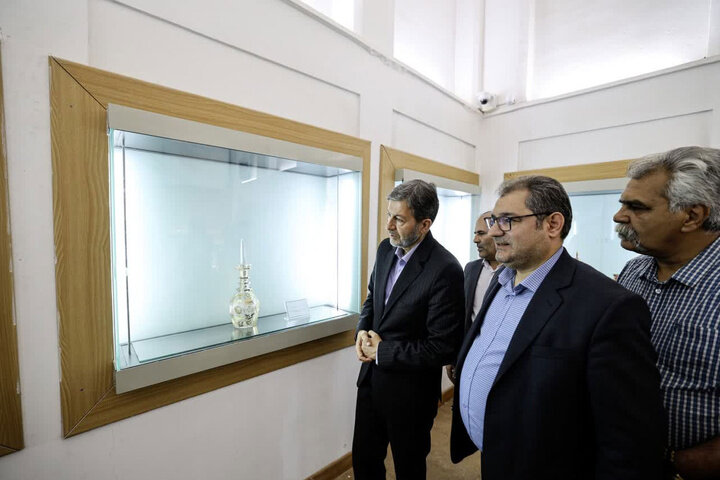Specialized enameling exhibition inaugurated in Isfahan

TEHRAN— A specialized enameling exhibition themed “fire and pattern” was inaugurated at the Museum of Decorative Arts in Isfahan, concurrent with International Museum Day on May 18, said the deputy director of Isfahan Cultural Heritage, Tourism, and Handicrafts Department.
Nourollah Abdollahi also said that given the planning and with cooperation of Isfahan Enamel Association, the exhibition with a focus on enamel work was inaugurated with presence of 50 outstanding artisans of Isfahan and in form of 100 selected works in a ceremony attended by Isfahan Governor-General Mahdi Jamalinejad, the provincial tourism chief Amir Karamzadeh, and a number of local artists and cultural heritage lovers, CHTN reported.
The fair, which began on May 18 to commemorate the exquisite art of enameling and put on display the remarkable works of enamel artisans, is open to visitors for one month, he concluded.
Although specimens of Iranian enamel work dating back to the 10th century AH and the Safavid era have been found, experts believe it has a more ancient history.
Enameling originated in Iran and then spread to other countries. French tourist, Jean Chardin, who toured Iran during the Safavid rule, made a reference to an enamel work of Isfahan, which comprised a pattern of birds and animals on a floral background in light blue, green, yellow, and red.
Some experts link the historicity of enameling in Iran to the Arsacides and Sassanid periods. However, the use of this art in the Islamic period is not clear before the reign of the seventh ruler of Mongol Empire’s Ilkhanid division in Iran, Ghazan Khan (694-703 AH), who introduced Mongol Persia to Islam. He acquired the science of chemistry in a short period and preferred to use his knowledge and endeavors for the art of enameling.
=================Origins
Enameling is, in essence, the art of connecting a glass surface to other bodies such as metallic surfaces. In order to make the transparent enamel powder, silica and sodium carbonate are used. For coloring the metal, oxidizing powders are added to the glazing powder containing tin oxide. It is referred to as a laboratory art, as the enameling artist should be skillful in handling chemical reactions.
Fine silver is used in almost all enameling because the enamel (glass) melts and sticks best to a pure metal. In simple words, enameling is the process of making metal models (fine silver usually) and then melting various colors and types of glass onto the model to create an artifact.
In a more scientific approach, vitreous enamel is defined as the colorful result of fusing powdered glass to a substrate by firing, usually between 750 and 850 degrees Celsius. The powder melts, flows, and hardens to a smooth, durable vitreous coating on metal, glass, or ceramic.
The paintings or patterns used for enamel works in Iran are traditional designs depending on the taste and preferences of the artist. In the Iranian version of enameling, copper and silver are the most dominant metals used. There are also special tools used in this ancient artistic endeavor such as furnace, pliers, press machine, brush and so on.
Enamel is usually used to embellish vase, jewelry and candleholder in addition to doors and chandeliers of holy shrines. Isfahan is the most important Iranian enameling hub. Enamel works can be washed with lukewarm water, soap and even ordinary detergents.
=================Enameling masters
The greatest master of enameling of Isfahan is Shokrollah Sanizadeh, whose ancestor was a renowned painter. One of the invaluable works of this master was used for printing a stamp for commemorating Iranian handicrafts in 2008-9 and registered as national heritage. The original artifact is being kept at the Museum of Traditional Arts and Handicrafts.
Among the distinguished students of Sanizadeh, one could refer to Gholamhossein Feizollahi, who is dexterous in designing beautiful patterns.
There are quite a few artists in Isfahan who produce very exquisite enamels. There is great demand for these works because of their artistic value and relatively low price.
These artists present their works in Chahar-Bagh Street and the vicinity of Naqsh-e Jahan Square.
Isfahan was the capital of Persia for 200 years during the 17th and 18th centuries, when it enjoyed prosperity.
Kilim weaving, woodworks, and metalworks are among other handicrafts that originated from Isfahan.
KD
Leave a Comment